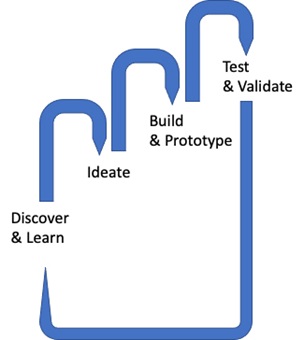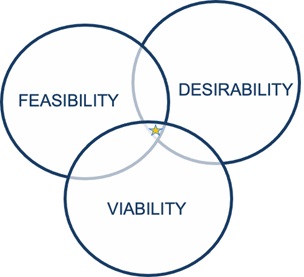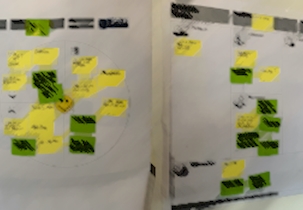Prototyping and business models
Article one in a two-article series about design thinking and business model innovation with new technology.
Behind every great business model are certain assumptions about the world, the market and how your product or service fits in the mix of customers, competition, and value creation.
There are tools and methods out there to help you model your value proposition, your business model and to analyze the market – but while modelling and analysis are strong and necessary tools in an innovation journey, nothing beats actual assumption testing and validation. Basic premises behind the oft overused term “design thinking” are exploration, sketching, testing, and learning – and applying this approach to your business innovation is a strong proposition for a better and more successful innovation journey.
Read article two
Testing business model innovation
The search for business modelling tools
In 2020, the Strategyzer team (behind the famous Business Model and Value Proposition Canvases), released the book “Testing Business Ideas”. This happened in the middle of FORCE Technology’s own two-year research project “Acceleration of Technology Based Innovation”, where FORCE, in collaboration with business departments of Aalborg University, Copenhagen Business School, and the Danish Technical University, explored business model innovation in technology-driven innovation.
With inspiration from trends in the “Lean Startup”, “Design Thinking” and “Sketching in Hardware” movements, we’re concerned with how to best help companies bring meaningful innovations with new technology to market in new products and services - with a successful business and business model innovation. All too often great technology fails in the market – and fine business models are hindered by the wrong technology or the wrong application. While we dig uncover many good approaches in our research and through interviews with companies and innovators, we were still looking for a way to formalize an approach to business model innovation that relied less solely on theoretical analysis and added more real life validation.
Additionally, we wanted a method that would allow for discovery, learning, reflection, and continuous improvement of new business models supported by new technology in, potentially, completely new applications. Interestingly, both our team and the Strategyzer team had come to the same conclusion – but with Alexander Osterwalder and James Bland (both of Strategyzer) providing the key insight, to how we can use the Value Proposition and Business Model Canvas to help find and build a path in an innovation journey.
Thinking like a start-up
It is an old truth, that the most important thing about a start-up is not necessarily the idea that the start-up is trying to get to market. It’s the team in the start-up. Before investing time or money, you should make sure, that the team has the right mix of entrepreneurial as well as operational competencies.
Many start-ups need to be able to pivot during their first few years of their existence. The reason is simple; while trying to bootstrap your company, you learn about your product, your customers, and your product - and you need to be able to adjust as your hypothesis about the world gets solidified into theory into facts. And this applies to all innovation, also in larger and more established companies – and especially when applying new technology, trying to attract new customers, or implementing a new or add-on business model.
One of the most common mistakes is to be biased by experience and “business as usual” that is not actually applicable in new product and technology development. To succeed, you need to be able to ask the right questions, inspect the answers you get and assess their validity – and then take the right decisions based on your insights. It sounds simple, but only a few of us can do this intuitively and unbiased. The rest of us needs help to help navigate the entrepreneurial path.

The perfect sweet spot of innovation
The most generally accepted diagram, that shows the three primary important aspects of new products or services is the feasibility, desirability, and viability trifecta. These three aspects, while covering a lot of ground, are worthwhile way-pointers in your innovation journey and cover market, business, application, technical and as well as operational aspects of your innovation. They are main building blocks in every business plan and pitch deck.
But these three aspects are not the only important domains. Increasingly, we see the need for even more considerations – and you can find several other Venn-diagrams trying to illustrate those and looking at other aspects of the innovation process. For example, there is one detailing the viability-aspects in a triple bottom-line of “people, planet and profit” and there is one detailing viability in varying degrees of “meaningful” or “worthwhile”.

Walking through the value proposition canvas, you get a chance to model the user and customer, their jobs to get done, current pains and the successes they seek. You get to model the value proposition that you will propose to your (model of the) user. As with all models – also those on paper – the canvas will not cover all bases and it is not enough by itself. But it will give you the headlines, sort the value of your product and service idea – and, as we will cover later, can direct your research and ideation.
From the Value Proposition Canvas, the next important step is to model the business that will support this value proposition. In this model of a business model, you can still see the “Innovation Venn” domains of desirability, feasibility, and viability and the nine elements of the Business Model Canvas thus fleshes out the most important aspects of a business model:
Desirability aspects
- Client/Customer Segments
- Client Relationships
- Value Proposition/Advantage
- Channels / Customer Experience
Feasibility aspects
- Key Resources
- Key Activities
- Key Partnerships
Viability aspects
- Cost Structure
- Revenue Streams
Business modelling with a canvas
Our team in FORCE Technology is experienced in modelling. For decades, we have worked in within the “explore, model, test and learn” modes of design-thinking based design and development. In the recent years, we’ve added the Value Proposition Canvas and Business Model Canvas to our toolbox and used it with many companies – and with the latest addition to of assumption mapping and validation (explained in part 2 of this article), we now have an operational, practical, and effective tool to extend our way of working into business model innovation and design.A modelling tool for innovation
As is often the case with modelling, using the canvases is an opportunity to get a shared experience and create a tangibility of inherent assumptions and biases in the team. More often than not, a good modelling session will result in surprising discussions and challenges about your product’s value proposition and business model - and we’ve seen even very tight-nit teams discover, that they had very different views on essential aspects of their models. It is important to know, that the canvases are tools both for modelling and for uncovering opportunities and challenges; a business model might be the result, business model modelling is the process of designing a business model – something that is often overlooked. In these cases, the business model canvas is used as a formal representation of a business model (which it can be), but less of a tool to explore and design a new model.
This article was written with funds from the performance contract 2018-2020 by the Danish Agency for Higher Education and Science.

Cyber Resilience Act: new cyber resilience requirements
/Article
The EU introduces new requirements for products, processes and documentation. Get an overview here.

How can AI boost efficiency and quality in production?
/Article
White paper explores how AI transforms production with efficiency gains and quality improvements.

Quantum Technology - Status in Denmark
/Article
Quantum technology holds immense strategic importance for global security and innovation.



